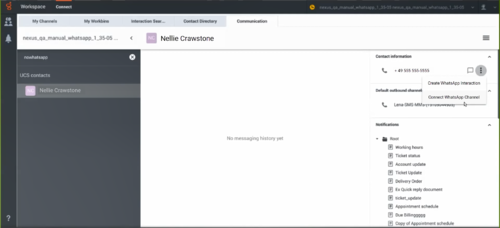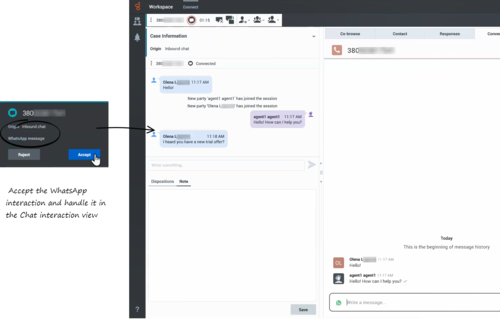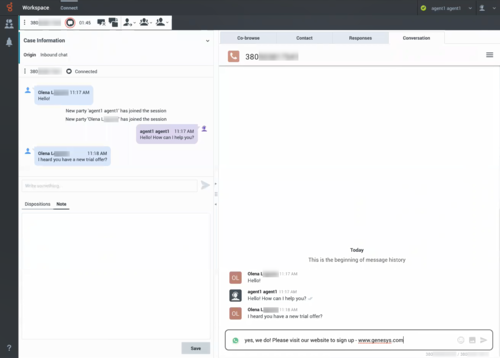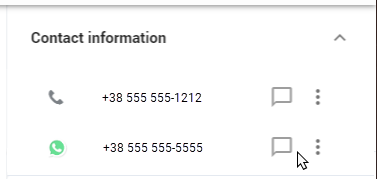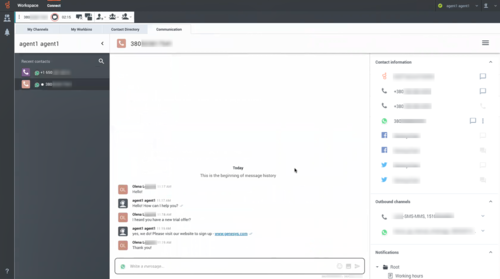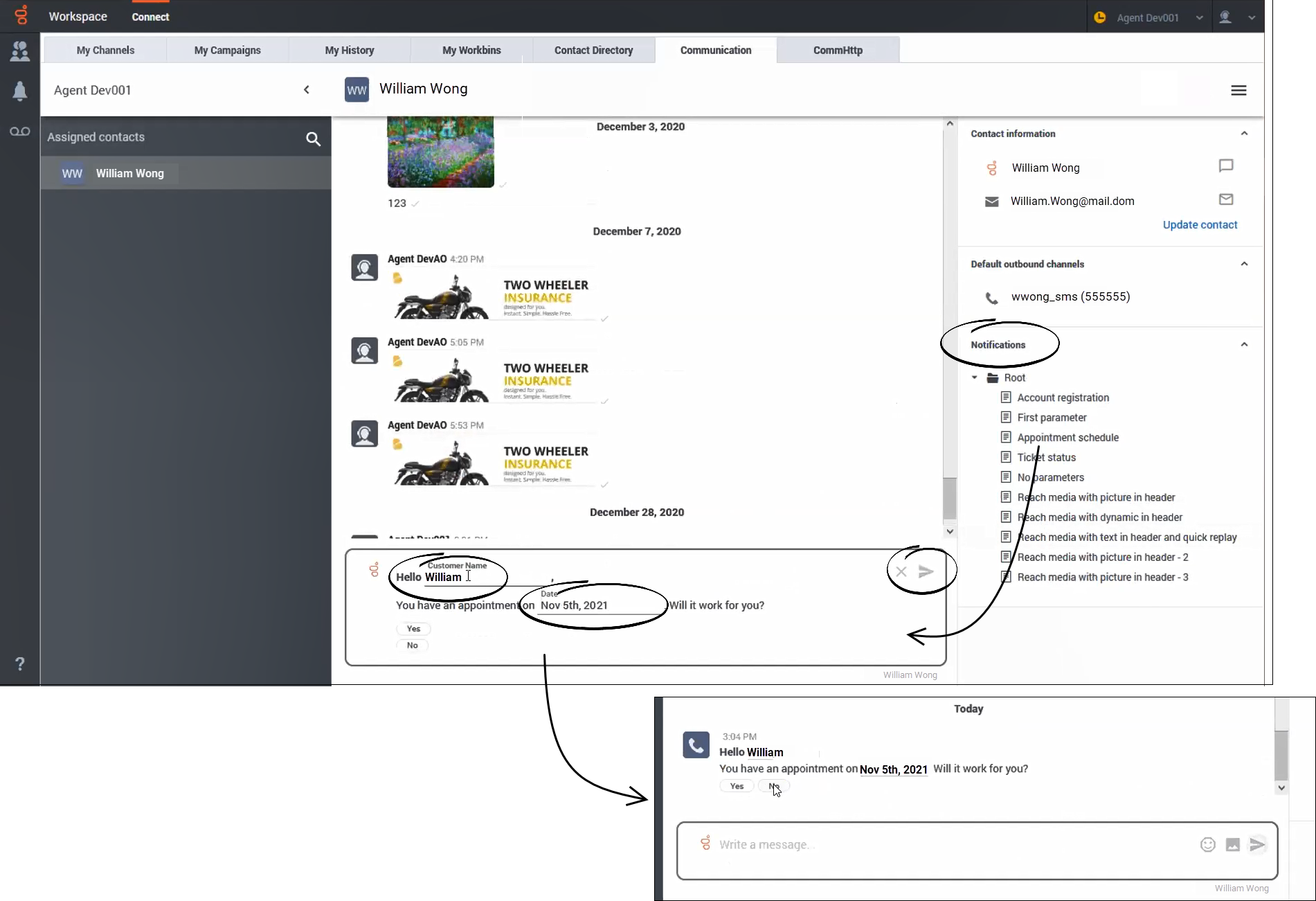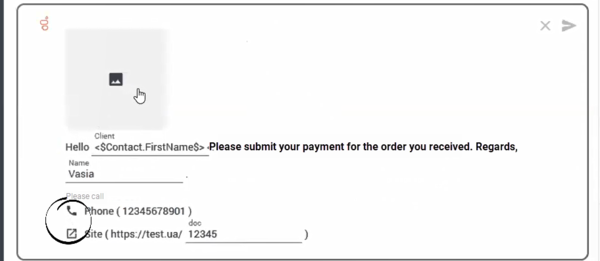WhatsApp Chat
Contents
The Workspace Agent Desktop Chat channel enables you to exchange chat messages (interactions) with a contact. Chat interactions include Web Chat, WhatsApp messages, Facebook Messenger, Twitter Direct Messages, and SMS messages.
- Due to continual changes to Workspace Agent Desktop, screenshots in this document might show interface elements that are not yet available for this product or might not accurately reflect what you see in the product when you use it.
- Some Workspace Agent Desktop features are available only for Genesys Engage cloud users and some only for Genesys Engage on premises users.
WhatsApp is a messaging service that enables the exchange of text messages, emojis, images, and Highly Structured Messages (HSM) between you and a contact through your computer. Typically, a contact sends you a message from a mobile device or computer. From your point of view, handling an WhatsApp chat session is no different from handling any other Chat session, whether you are handling a one time interaction or are continuing a conversation.
When a WhatsApp interaction is routed to your desktop, you handle the interaction by exchanging messages with your contact. If either you or the contact ends the session, the interaction is done. To close the interaction, you must mark it as Done. However, sometimes you must continue a WhatsApp conversation. Perhaps you had to take time to find additional information for the contact or start a business process in your company before continuing the conversation.
If your account is enabled for asynchronous chat, you can continue an interaction after the initial interaction is ended by using the Conversation tab in the interaction window or the Communication tab.
If you have not yet marked a closed interaction as Done, in the Conversation tab, the transcript of your current interaction and all previous chat interactions with the contact is displayed. You can scroll through it or use the Search feature to find messages containing keywords. To reactivate the session, type your message in the Message field and click Send.
To reactivate an interaction that is closed and marked as Done, perform these steps:
- In the Connect group, select the Communication tab.
- Open the Contact view.
- Select the contact from the list of contacts.
All previous interactions that your contact center has had with the contact are displayed in the transcript area on the right. To reactivate the chat interaction, click the Chat button (![]() ) to open the Chat interaction view.
) to open the Chat interaction view.
Connecting to the WhatsApp channel
When you select a contact from the list of contacts in the Communication tab, the list of channels and phone numbers available for a contact is displayed in the Contact Information area. To make a call or perform other actions, such as sending an SMS or a WhatsApp message, click the Channel Action menu next to the channel you want to use.
If the contact has a WhatsApp account that is not connected to your organization, send a request to WhatsApp to connect the account to your organization by selecting Connect WhatsApp Channel. When the contact approves the request, the WhatsApp channel is displayed in the Contact Information area.
If the contact does not have a WhatsApp account for a phone number, ask the contact to confirm which number to use. If the number does not exist in the Contact Information in the Contact Directory, you can add the number. When the number displays in the Contact Information area, select Connect WhatsApp Channel from the channel action menu.
After you have added the WhatsApp channel, the channel action menu contains two options:
- Create WhatsApp Interaction: Create and send a new WhatsApp interaction to the contact.
- Validate WhatsApp Channel: If you get an error trying to send a WhatsApp message, validate that the WhatsApp channel is still available for the contact. If there is an error, a warning icon is displayed next to the channel in the Contact Information area.
WhatsApp Interactions
Contacts can send WhatsApp messages your their device to your organization's WhatsApp channel. When WhatsApp messages are routed to you, handle WhatsApp messages just like you would handle a Chat interaction with one of your contacts.
Read the messages from your contact in the Transcript area. Type your messages in the Message Composition field.
The Contact tab contains information about the contact including the phone number that sent the WhatsApp message if applicable. You can update the contact information and view the history of interactions with the contact.
If you have had previous chat/WhatsApp interactions with the contact, the full transcript is in the Conversation tab.
Conversation tab
The Conversation tab is displayed in the Chat Interaction view.
The transcript of the chat is displayed both in the Transcript area and the Conversation tab. The Conversation tab also contains the transcripts of all previous chat interactions that your contact center has had with the contact.
The Conversation tab allows the following actions:
 : Click to refresh the conversation display.
: Click to refresh the conversation display. : Click to send messages you type in the Message Composition area.
: Click to send messages you type in the Message Composition area. : Attach an image.
: Attach an image. : Send an emoji to your contact.
: Send an emoji to your contact.- CHAT: Filter messages to show chat (private) type only.
- OPEN MEDIA: Filter messages to show open media (public) type only.
You can also start a WhatsApp interaction by clicking one of these buttons on the right side of the Conversation tab:
If you or the contact end the session, you can keep the Chat interaction view open while you perform other actions or business processes. Check with your supervisor about whether to mark the interaction as Done or keep the interaction view open while you perform other duties.
Keeping the interaction view active might affect your Ready status.
Communication tab
The Communication tab in the Connect group lets you continue WhatsApp chat conversations that you or others at your contact center have had with your company's contacts.
After an agent or the contact leaves a chat session, you can continue the conversation. Find the contact in the Communication tab, then select their name from the contact list.
To continue the conversation, perform one of the following actions:
- Type in the Write a Message field and click Send.
- Click the Chat icon to open a new Chat interaction view.
In some environments, the Write a Message field is not available. To start a new interaction with the contact click the Chat icon and select a channel icon, such as Chat, Email, SMS, or WhatsApp.
When the contact responds, you receive a notification on your desktop. To open the Communication tab of the Connect group, click Show. To respond to the contact and continue the conversation, click the Chat icon to open the chat in a new Chat interaction view.
The Communication tab has two areas, the Contacts list and the conversation transcript area.
- To see the conversations that contact has had with your company, select a contact in the Contacts list. If there is an unread message from one of your contacts, a number is displayed next to their name indicating the number of unread messages.
- To see Web Chat, WhatsApp, Facebook Messenger, Twitter Direct Messages, and SMS transcripts, choose CHAT.
- To see public Facebook messages and Twitter Tweets that involve your company, choose OPEN MEDIA.
- The conversation transcript area displays all the chat interactions that the selected contact has had with your company.
The conversation area allows the following actions:
 : Click to send messages you type in the Message Composition area.
: Click to send messages you type in the Message Composition area. : Attach an image.
: Attach an image. : Send an emoji to your contact.
: Send an emoji to your contact. ': Click to start the Chat Interaction window and continue the conversation there with access to all the interaction window features such as Contact Information, Contact History, and Standard Responses. Note: Genesys recommends that you switch to a chat interaction window to ensure your chatting time is recorded for KPI purposes.
': Click to start the Chat Interaction window and continue the conversation there with access to all the interaction window features such as Contact Information, Contact History, and Standard Responses. Note: Genesys recommends that you switch to a chat interaction window to ensure your chatting time is recorded for KPI purposes. : Switch the display of the Contacts list area.
: Switch the display of the Contacts list area.
WhatsApp interaction can also be started by clicking one of these buttons on the right side of the Communication tab:
For information about using the Communication tab, refer to Chat.
Sending notifications
The Notifications view contains templates for notifications that you can send to a contact. Notifications are preformatted messages that you can send to a contact through the WhatsApp channel.
If your organization has never connected with the contact over the WhatsApp channel before, you must first Connect and Validate the WhatsApp number.
To send a Notification message to your contact, perform the following steps:
- Open the Notifications view.
- Click the name of a Notification document.
- Review and edit the Notification template displayed in the Message field in the transcript area.
- Click Send.
The Notification template might contain blank fields for you to fill in. Your system might automatically fill in fields in the template. Fill in or update fields as required.
Click Send to send the Notification to your contact. The Notification document is displayed in your contacts WhatsApp account.
Many Notification documents contain reply buttons or other feedback mechanisms enabling the contact to reply to the Notification. For example, you might send a Notification containing a proposed appointment time with Yes and No buttons that the contact can select to respond to the Notification.
The contact's response is displayed in the WhatsApp transcript area.
More features of Notification templates
Notification templates can contain some of the following elements:
- Custom text fields. You might have to fill fields with information, such as the customer's name, an account number, or other information. Some fields might be automatically populated with the information from information about the contact stored in your organization's database.
- Images. Some notifications include images. Some notifications include a placeholder in the template for an image that you add. To add an image, click the placeholder, then browse to an image or drag-and-drop an image into the template.
- Reply buttons. Some notifications include buttons that enable your contact to respond to questions or confirm a condition. When the contact clicks a button, their selection is added to the interaction transcript.
- Action buttons. Actions can include starting a phone call or linking to a website.

